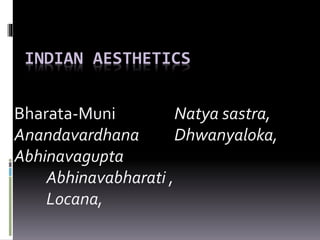
Indian aesthetics 1
- 1. INDIAN AESTHETICS Bharata-Muni Natya sastra, Anandavardhana Dhwanyaloka, Abhinavagupta Abhinavabharati , Locana,
- 2. Indian aesthetics areas POETRY, MUSIC AND ARCHITECHTURE PAINTING AND SCULPTURE
- 3. UPANISHADS 108 Upanishads first 13 as mukhya, 21 as SāmānyaVedānta, 20 as Sannyāsa, 14 asVaishnava, 12 as Shaiva, 8 as Shakta, and 20 asYoga. Aithereyam, Kena, Chandokya, Brihadharanyaka, Isovasya,Thaithariyam, Mandukya, Mundaka, kata, Prasna
- 4. Schools of philosophy Asthika Nasthika (Budhism, Jainism , Lokayata)
- 5. Schools of Indian aesthetics Alankara School by Bhamaha, Riti School byVamana, Vakrokti School by Kuntaka, Dhvani School by Anandavardhana Auchitya School by Kshemendra
- 6. “From the Indian points of view aesthetics is the science and philosophy of the independent arts—the arts which present the Absolute in sensuous garb in such a way that their products serve as the effective mediums for the getting of the experience of the Absolute for such connoisseurs as possess the necessary subjective conditions. - K. C. Pandey
- 7. Art and Life Art and life in India have been inextricably intertwined. Art as a way of life, art as ritual, art as decoration, and art as unity with God. From the abstract to the figurative, and from the figurative to the abstract
- 8. Natyasastra Visible poetry with prayoga Performer (nata) centric Lokavrithianukaranam natyame thanmayakrita (imitation of the world) (thrailokashasya sarvasya natyam bhavanukirtanam) suggestive (based on natyadahrmi), rather than realistic acting based on lokadharmi
- 9. Aim of natya Rasa Religious and moral Dharma, artha, kama and moksha It offers religion (duty) for religious people, pleasure for pleasure seekers restraints for the ill behaved, tolerance for the well behaved courage to the cowards and energy to the braves knowledge for the unknowing and wisdom for the wise enjoyment for the rich and solace for the worried money for the needy and stability for the disturbed. Brahmandasahodara
- 10. Origin of natya Devas under Mahendra approached Brahma and wanted something that teach and please and accessible for all the people( vedas were not allowed to shudras) Four elements from four vedas Padya, gita, abhinaya and rasa (text, music, acting and emotions) rupaka
- 11. Rupaka Rupaka is divided into ten natak, prakarana, bhana, prahasana, dima, vyayoga, samavakara, vithi, anka, and ihamriga. There are eighteen classes of uparupaka, the most important of which are Natika, Sattaka,and Trotaka.
- 12. Vastu (the plot), neta (the hero), and rasa (the sentiments) - essential constituents of a drama or rupaka Sanskrit plays Absence of tragedy Interchange of lyrics with prose Sanskrit and prakrit Begins with nandi and ends with bharatavakya
- 13. Rasa “Vibhavanubhava Sanchari(vyapichari) samyogad rasa nispatti” – Bharata Vibhava, Anubhava &Vyapicharibhava Nine rasas: Hasya, Sringara, Karuna, Roudra, Bhayanaka, Bhibalsa, Atbhuta,Vira and Santa
- 15. Vibhavanubhava sanchari Vibhava- objective condition leading to emotion. Alambana vibhava & Udhipana vibhava Anubhava – expression of emotions Vyapichari bhava- diverse emotions leading to the dominant emotion
- 16. Rasa & Sthayeebhava Rasa – aesthetic expression Sthayee bhava – dominant (permanent) emotion Rati (Sringara), Hasa (Hasya), Soka (Karuna), Krodha(Roudra), Utsaha(Veera), Bhaya(Bhayanaka), Jugupsa(Beebhalsa), Vismaya(Atbuda), Nirveda(santa)
- 17. Sthayibhava Ratirhasasch shokasch krodhotsaho bhayam tatha Jugupsa vismayaschti sthyayibhāva ha prakirtita (N.S, 6.18)
- 18. Rasa theorist Udbhata Lollata -’ Utpatti vada’. (Rasa – effect,Vibhava – cause) Sankuka Bhatta Nayaka -’hridaya darpana’ Questioned the theories of Lollata and Sankuka Rejected ‘Anumana’ and vyanjana as factors leading to Rasa nishpati
- 19. Lollata Rasa is an effect whileVibhavas are its direct cause.(Karaka Hetu) (Rasa is nothing more than an intensified and heightened Sthayibhava as a result of the combined effects of the play, the players and various theatrical devices.) Rasa is located primarily in the characters. Rasa-nispatti (realization of Rasa) becomes Rasa- utpatti (production of Rasa) or upaciti (intensification of Sthayibhavas culminating to Rasa)
- 20. Lollata Vibhavas awaken, Anubhavas support andVyabhicaris Bhavas strengthen theSthayibhavas The locus of Rasa and focus of attention are characters, the imitating actors come secondarily The spectators are charmed by the grandeur of theatre and the performing skills of the actors and what they are enjoying are not their own permanent emotions but the upacit sthayibhava (intensified permanent emotions) of the characters and indirectly of actors. This communication happens through the actors and their acting skills.
- 21. Sankuka The cognition of Sthayibhavas is not possible withoutVibhavas asVibhavas are the linga through which the Sthayibhavas are cognized Questioned the theory of Rasa being the intensified Sthayibhava. Rejects Lollata’s classification of Rasa ( Hasya – smitha, hasitha, vihasitha, upahasitha, apahasitha & athihasitha) Certain sthayi never intensifies
- 22. Bhatta Nayaka Bhuktivada Hridayadarpana Questioned the theory of ‘Dhwani’ Sadharnikarana, (Universalisation/Generalisation/ Transpersonalisation of emotions in Arts) advocated a three function (Vyapars) theory through which language, specially in poetry, accomplished its desired task.
- 23. Sankuka only through vibhavas the spectators infer a sthayi in the actor which in reality is not there. The realisation of Rasa is a process of logical inference (vibhavas - anumapakas , Rasa anumapya.) Imitation of sthayibhava leads to Rasa
- 24. Bhatta Nayaka Rejected theories of Lollata and Sankuka Opposed the theory of ‘Dhwani’ in his work Hridaya darpana Sadharnikarana, (Universalisation/Generalisation/ Transpersonalisation of emotions in Arts) Advocated a three function theory (vyapars) through which language, specially in poetry, accomplished its desired task
- 25. Bhatta Nayaka ‘Abhidha’ - contains indication (lakshana) -Enables the artist to convey the meaning Bhavakatwa (bhavana) – emotive meaning Bhojakatwa ( bhogikarana) - relish
- 26. “Thus dominant emotions –Sthāyibhāvas, aroused by objects – Anubhāvas, excited by excitants – Uddipanvibhāvas, manifested through physical or movements consiquents – Anubhāvas, nourished by transitory feelings – Sancaribhāvas. are relished by the sympathetic readers or audience as Rasa.The reader is not conscious of all these ingredients while relishing any sort of sentiment. He only enjoys the sentiment as a fountain that gives him thrill and pleasure.” -Rama Kanth Sharma
